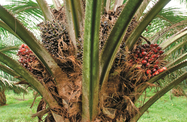The palm oil industry in Malaysia appears set for an uncertain few months, with a number of factors coming into play over the last quarter of the year that could push already low prices down even further, just at the time when production is about to peak.
As of the end of September, Malaysian palm oil prices were down 6% on the beginning of the year. Moving into October, the commodity was trading at $716 a tonne, with predictions it could fall further in the lead-up to the new year.
Malaysia has seen output rise monthly through to August, and while September’s figures have yet to be released, it is expected that volume will again be up. Some estimates put September’s production at close to 2m tonnes, a sharp jump from the 1.74m tonnes of the month before, which itself represented a 3.6% rise over July. This continued increase in output, which is likely to be maintained for the rest of the year – the high season – could further force down global prices as supply overtakes demand.
Also bearing on palm oil prices is the rising tide of soy oil flowing into the market, with the US soy crop set for a better-than-expected harvest and soybean stocks at higher levels than normal for this time of year. This has pushed soybean prices down to near two-year lows as of early October, a trend that will undercut demand for Malaysian palm oil.
Falling oil prices also set to weigh on sales
Another factor weighing down palm oil sales and pressuring prices is the drop in the cost of conventional crude oil. With oil prices falling, there is less appeal for biofuels in the market, and rising output from Libya combined with concerns over demand in the US as part of the fall-out from the shutdown of government, have pushed oil prices down. Benchmark Brent crude was trading at less than $108 a barrel in early October; WTI crude was lower still, dipping below $102, with analysts predicting a further decline in the weeks ahead as price instability posed by a potential US military strike against Syria recedes.
According to Dorab Mistry, head of vegetable oil trading with Indian conglomerate Godrej Industries, palm oil could fall to a four-year low of $617 a tonne in 2014 if crude oil prices go below the $100-a-barrel mark. This would represent a 13% fall on present prices, Mistry told an industry conference in late September.
“The fundamentals of the oilseed and vegetable oils complex are clearly bearish,” he said.
One factor that could boost sales is the drop in the value of the ringgit, which has retreated almost 9% since May. This has made exports more appealing, at least in some markets, though not in those that, like Malaysia, have been hit by the outflow of funds from developing economies. While the weaker ringgit may boost overseas sales, an easing of local currencies against the dollar has taken place in many of Malaysia’s key markets, such as India where the rupee has fallen by 12% since the beginning of the year. This means that any advantage accrued from the devaluation of the ringgit is offset by similar downward moves elsewhere.
Government plans could drain off excess
While palm oil producers may face difficulties in boosting sales abroad, help may be at hand at home. The government has said it is considering lifting the levels of palm oil added to diesel fuel as a way of boosting domestic demand. Malaysia requires a 5% palm oil additive to diesel; the resulting biofuel accounts for a significant portion of palm oil consumption, with nearly 250,000 tonnes of palm oil/diesel blend consumed in 2012, a figure the state aims to double by 2014. Indonesia recently announced it would be raising its palm oil input to biodiesel from 7.5% to 10% next year. Any similar move by Malaysia would help soak up excess production, though the government has yet to set any timeframe for an increase or how far above the current levels the rise would be.
Further state support came in mid-September, when the government decided to keep taxes on palm oil exports unchanged in October, maintaining the 4.5% tariff that has been in place since March. The decision is expected to help boost overseas sales during the peak harvest season and reduce the risk of a large build-up in stockpiles.
It may not be until well into the new year, when local production tapers off, that prices may start to move upwards to any significant degree, though crop losses due to adverse weather or a sudden jump in crude oil prices could give a boost to Malaysia’s palm oil sales. For the present, it seems the best producers can hope for are steady sales and for prices to remain at current levels.

